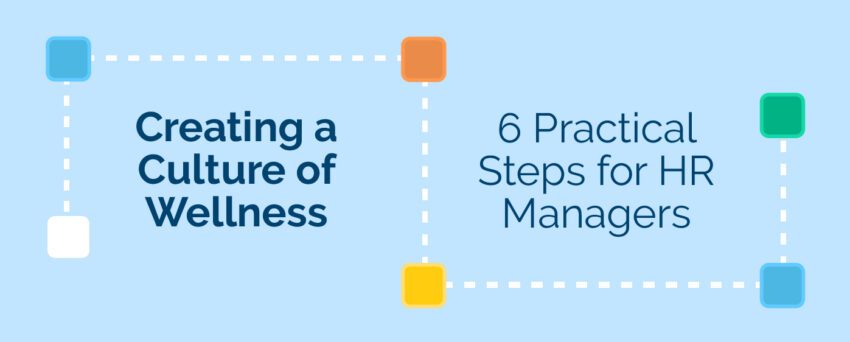15May 2024
Human resources (HR) managers are the architects who create a thriving culture of wellness within their organization. Fostering an environment that prioritizes employee health and happiness allows HR professionals to boost both individual well-being and collective productivity. Amid a corporate world that often champions hustle culture, emphasizing employee wellness may seem like a radical change — but it’s a transformation that’s rapidly proving its worth.
Across industries, from high-pressure tech environments to traditional office environments, organizations are reevaluating the worth of their human resources beyond their utilitarian function. Let’s explore the actionable steps HR managers can take to weave a culture of well-being into the fabric of their organizations.

1. Understand the Current Landscape of Well-Being in the Workplace
The foundation of any successful initiative is a thorough understanding of the challenges and opportunities present in a company. Wellness statistics reveal high levels of stress, mental health issues, and physical ailments are not just personal problems, but also productivity and retention issues for an entire organization.
The Impact of Workplace Wellness on Business
Employee wellness is directly correlated to productivity rates — with healthy and happy employees significantly outperforming their stressed-out or ill colleagues by 13 percent. A positive work environment leads to reduced absenteeism, higher engagement, and improved job performance.
The Role of HR Professionals
As the gatekeepers of employee well-being in an organization, HR professionals are uniquely positioned to drive initiatives that promote wellness. They have access to data on employee health and can collaborate with management and employees to determine the most effective strategies.
Employee Wellness Challenges
In navigating the path toward a healthier workplace, HR managers often encounter several obstacles. Some of the common challenges they may face include:
- Gaining leadership support – Secure leadership buy-in by demonstrating the clear return on investment (ROI) of wellness programs. Utilize data and case studies showcasing the link between employee well-being and improved productivity, profitability, and reduced healthcare costs.
- Identifying the specific needs of a diverse employee base – Conduct surveys and focus groups to gather direct feedback from employees about their wellness needs and preferences. Use this data to tailor programs that address the physical, mental, and emotional health of a diverse workplace.
- Designing sustainable wellness programs – Create programs that offer a continuous engagement strategy rather than one-off events. Incorporate a mix of health assessments, education, fitness activities, and mental health resources that evolve based on ongoing employee feedback.
- Encouraging employee participation and engagement – Leverage internal communication channels to highlight the personal and professional benefits of participation. Introduce incentives and friendly competitions to make wellness activities fun and engaging. Foster a culture where management leads by example in prioritizing health and wellness.

2. Build a Foundation for Leadership
The endorsement of leadership can shape the success of any initiative within a company. HR managers must secure this support to create a culture where wellness isn’t an added benefit but a foundational aspect of a company’s values.
The Role of Leadership
Leaders set the standard and priorities for an organization — and when wellness is a priority for them, it becomes a priority for everyone. HR managers should articulate the business case for prioritizing employee wellness and help leadership understand its strategic value.
Strategies for Gaining Leadership Support
To ensure the success and sustainability of wellness initiatives, forging strong support from company leadership is imperative. To gain leadership support, HR professionals can implement some of the following strategies:
- Share case studies showcasing wellness initiatives that have yielded positive results
- Demonstrate how employee wellness drives engagement and innovation
- Develop a clear and convincing implementation plan

3. Assess and Address Employee Needs
Employee well-being is not a one-size-fits-all endeavor. HR managers have the responsibility to identify and address employees’ unique needs through comprehensive assessments and inclusive programs.
Conducting Wellness Assessments
HR managers can gain valuable insights into employee wellness needs with surveys, focus groups, and one-on-one conversations. These assessments should cover various aspects of wellness, including physical, mental, emotional, and social well-being.
Tailoring Wellness Initiatives
To create a supportive and inclusive workplace, it’s essential to consider the diverse wellness needs of employees. Upon reviewing wellness assessment results, HR managers can tailor programs to address specific issues such as:
- Stress management workshops – Offering sessions focused on mindfulness and meditation techniques that employees can use during the workday to manage stress levels
- Flexible work arrangements – Implementing policies that allow for telecommuting, flexible hours, and compressed workweeks to help employees achieve a better work-life balance
- Nutrition and fitness programs – Establishing partnerships with local gyms for discounted memberships or organizing weekly group exercise classes for employees, and providing healthy eating workshops or inviting nutritionists to speak about balanced diet principles
- Mental health support resources – Making confidential counseling services available to employees, as well as hosting seminars on topics related to mental health awareness and coping strategies
 4. Launch Employee Wellness Programs
4. Launch Employee Wellness Programs
When HR professionals are armed with an understanding of employee needs and the backing of leadership, they can develop and deploy a diverse range of employee wellness programs.
Diverse Wellness Initiatives
Implementing a variety of wellness initiatives is pivotal for addressing the multifaceted needs of employees. Wellness programs can range from traditional to innovative, including initiatives such as:
- On-site gyms or fitness classes – Providing spaces or partnerships with local gyms can encourage physical activity among employees — reducing stress, and improving overall health
- Mental health days off – Allowing employees additional days off specifically for mental health can help with alleviating burnout and promoting work-life balance
- Employee assistance programs (EAP) – Offering confidential counseling services for employees dealing with personal or work-related issues can improve mental well-being
- Skill development workshops – Conducting workshops on time management, communication skills, and other personal development areas can increase employee confidence and job satisfaction
- Subsidized healthy meals or snacks – Implementing programs that offer healthier food options at the workplace encourages better eating habits among employees
Launching Wellness Programs Successfully
To ensure a holistic approach to employee well-being, wellness programs must cover a broad spectrum of health and personal development topics. To launch wellness programs that gain traction, HR managers should:
- Pilot programs to gauge interest and effectiveness
- Communicate the value of the programs clearly
- Make the programs as accessible as possible
- Ensure they are inclusive of all employees
- Regularly review and adjust offerings to maintain
 5. Implement Communication and Engagement Strategies
5. Implement Communication and Engagement Strategies
A well-conceived wellness program is only as good as its ability to reach and resonate with employees. Clear communication and engaging strategies are essential to ensure participation.
The Art of Effective Communication
HR managers must excel in the art of communication to maximize the impact and reach of workplace wellness initiatives while increasing workplace productivity. As much as 49 percent of employee productivity can be impacted by poor communication. To promote and enhance participation in wellness initiatives, HR managers need to communicate:
- The “why” behind wellness initiatives
- The programs available and their benefits
- How employees can participate or access resources
- The value of feedback and ongoing dialogue
Engaging Employees in Wellness
Maximizing employee well-being is a dynamic process that requires intentional strategies to involve and inspire employees. Engagement can be fostered through:
- Promoting a supportive work environment where wellness discussions are encouraged
- Utilizing multiple communication channels, such as email, social media, and in-person meetings
- Creating wellness champions within each team to promote programs and serve as points of contact
 6. Measure Success and Make Adjustments
6. Measure Success and Make Adjustments
To refine and scale wellness efforts, HR managers must establish clear metrics, collect data, and make informed adjustments based on their analysis. HR professionals should set specific and measurable goals for wellness programs, such as participation rates or improvements in health outcomes.
Collecting data on program usage, employee feedback, and other relevant metrics to evaluate the effectiveness of initiatives and make informed decisions.
Key Metrics for Evaluating Wellness Programs
Evaluating the success of wellness programs is critical for continuous improvement and ensuring they meet the needs of employees. Common metrics include:
- Employee absenteeism and turnover rates – These metrics are indicators of employee satisfaction and overall health. High absenteeism can signal unresolved health issues or low workplace morale — while high turnover might point to dissatisfaction with the wellness initiatives or the work environment in general.
- Participation levels in wellness programs – Tracking the number of employees who enroll in and actively participate in wellness programs provides insight into the program’s relevance and appeal. High participation rates usually indicate that the programs are meeting employee needs and interests.
- Employee feedback through surveys and informal discussions – Direct feedback from employees about wellness programs offers invaluable insights into what is working and what isn’t. This feedback can guide HR managers in making necessary modifications to improve the offerings.
- Productivity and performance indicators – Improvements in employee productivity and job performance can often be linked to successful wellness programs. These indicators can show the tangible benefits of investing in employee health and well-being.
Strategies for Continuous Improvement
HR managers can employ several strategies aimed at continuous improvement. To ensure that wellness initiatives remain effective, professionals in HR may consider:
- Conducting periodic program reviews
- Continually seeking and acting on feedback from employees
- Iterating on existing programs or introducing new ones to address changing needs and preferences
Final Thoughts on Enhancing Employee Wellness
Creating a culture of wellness is a continuous process of adaptation, engagement, and evaluation. HR managers are on the front lines of this cultural shift — and their proactive efforts will shape healthier, happier, and more productive workplaces.
By taking some of these practical steps, HR managers can spearhead initiatives that lead to healthier employees and contribute to a positive workplace culture. With employee wellness at the center of operations, companies can look forward to a more engaged, loyal, and productive workforce. The time to prioritize wellness is now, and the steps you take today will lay the groundwork for the successful organizations of tomorrow.
Contact our team today, and we’ll help you set up an electronic document management system that places employee wellness at the heart of your corporation.

